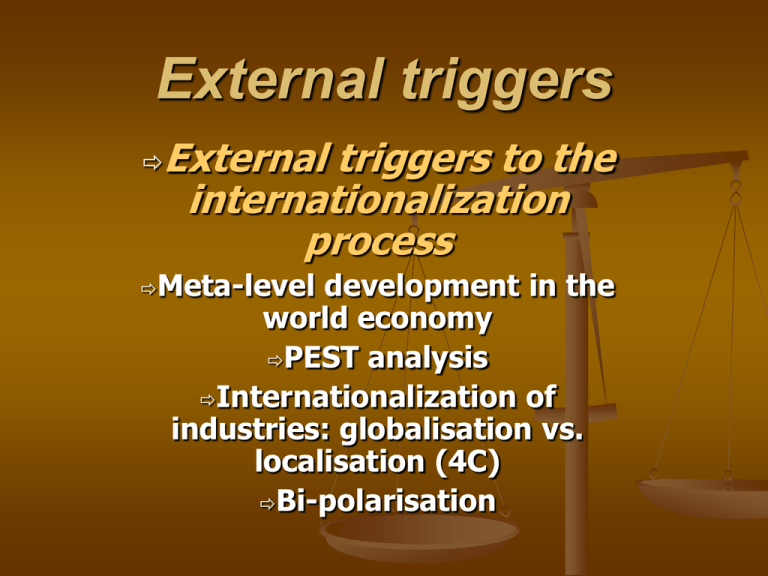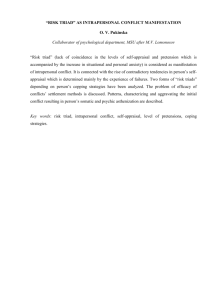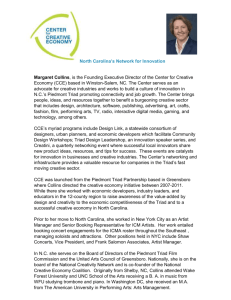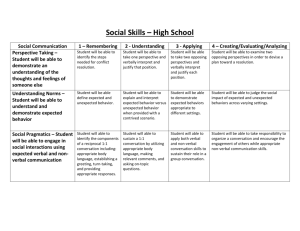ISM_Barakonyi_IV_
advertisement

External triggers
External triggers to the
internationalization
process
Meta-level
development in the
world economy
PEST analysis
Internationalization of
industries: globalisation vs.
localisation (4C)
Bi-polarisation
External triggers to the
internationalization process
Driving forces toward globalization - opposite
forces => tensions
Current phase => Triggers may create conditions
=> Discontinuity => Next phase
Movement: bidirectional
increasing int’l exposure
decreasing
3-Externel triggers-a 34 /
2
External triggers
INTERNATIONALISATION
Market
penetration
Product
extension
Meta trends
Intern’l
business
development
Restricted
national
market scope
Geographical
expansion
Industry
competition
Product
development
Organizational
dynamics
Vision
mindset
RETRENCHMENT*
Internal triggers
Figure 2.1. Developing
an triggers-a
international
business strategy
3-Externel
34 /
3
External triggers
Discontinuity
Current phase
New international
strategic thrust
Next phase
Internal triggers
Figure 3.1. External and internal triggers to a stage change
3-Externel triggers-a 34 /
4
Three levels:
–meta level
–industry level
–Firm-specific level
Interrelatedness!!!
Meta level:
broad trends, collectively help to shape
competitive environment
Question: how they relate to individual
industries and competititors
3-Externel triggers-a 34 /
5
External triggers
TRINITY
Meta level
World trade
PEST analysis
Industry level
Firm level
Globalisation v
localisation
Bipolarisation
Figure 3.2. External triggers at the meta, industry and firm-specific levels
3-Externel triggers-a 34 /
6
External triggers
External
triggers to the
internationalization process
Meta-level
development in the
world economy
PEST
analysis
Internationalization of
industries: globalisation vs.
localisation
Bi-polarisation
Meta-level development in
the world economy
the “Triad”
interblock trade
direct investment
dynamic adjustment
3-Externel triggers-a 34 /
8
3-Externel triggers-a 34 /
9
Triad
1/5 of global population, 4/5 of world
output (GNP)
more manufacturing/service divisions
nationality of companies: outdated
national government can not obstruct or
impede
raising import penetration: interlinked
nature
USA import:
– 1970: 4.1% GNP
– 1980: 9.1 % GNP
– 1990: over 18%
Main competitors for indigenous firms
are increasingly
to
be
foreign!
3-Externel triggers-a 34 /
10
Capitol market
Global marktes
Conflicts of national
policies
Goods, services
Regionals
markets
Regionals
markets
National
markets
Regionals
markets
Integration,
harmonization and
protectionist regional
policies
Labor markets
National employment,
training and fiscal policies
3-Externel triggers-a 34 /
11
35%
740 m
Western Europe
28%
350 m
Central & Eastern Europe
7%; 390m
34%
760m
NAFTA
30%
370 m
South & Central America
4%; 390m
6%
The
‘Triad’
25%
2300m
Japan, Australia &
‘Tigers’ 20% 400m
China, other Asian-Pacific
developing 5%; 1900 m
1700m
Africa, Middle East, Indian subcontinent
Figure 3.3. The ‘Triad’ and the world economy, 1991: percentage of world GNP; population in
3-Externel triggers-a 34 /
12
millions
NAFTA
28%
South & Central
America
40%
Western Europe
34%
Central & Eastern
Europe
22%
Japan and ‘Tiger’
economies
68%
26%
China & Asia Pacific
Africa, Middle East &
India
2001
1991
47%
0
2000
4000
6000
8000
10,000
Figure 3.4. Forecast growth of world ‘Triad’ markets, 1991-2001: levels of GNP (billion
3-Externel triggers-a 34 /
13
USD) and estimated percentage changes over the period {World Bank]
1995: Uruguay Round of the GATT: significant reduction in the
trade barriers
cuts in tarifs
bringing in farm products, textiles, services
intellectual property rights
conditions: when a state allowed imposing trade barriers
World trade growth > world outcome=>
XXI. Century: interlinked economy is likely grow faster =>
international competition is increasing more quickly than
output grows
EU, NAFTA: large unified regional trading area
Liberalization promoted
inter- and
intra-block trade!
3-Externel triggers-a 34 /
14
Intra-Europe 1214.0 $bn (35,4%)
Europe
129.3 $bn (3.7%)
174,7 $bn (4.9%)
152.7 $bn
(4.4%)
184.8 $bn
(5.3%)
Asia
America
153.6 $bn (4.4%)
236.4 $bn (6.7%)
Intra-Americas 270.4 $bn
(7.7%)
Key:
= Exports to
Intra-Asia 413.5 $bn (11.8%)
Others: 14.9%
Figure 3.5. Projected merchandise trade in US$ billion and as a percentage of world
3-Externel
34 /
15
trade for the
year triggers-a
2005 [GATT
Report]
1987
1988
1989
1995
87
100
80
63
63
54
60
40
20
0
-7
-20
-40
-22
-5
-25
-8
-24
-33
-18
-18
-21
-34
-60
-51
Europe
USA
Japan
Rest of world
Figure 3.6. Trade balance of world electronics industry: surplus/deficit in US$ billion
3-Externel triggers-a 34 /
16
Direct investments
raising exchange rates (Japan, Germany)
hard to raise productivity
Foreign assets: Japan $514 bl, Germany $300bl
(1992)
World trade flows increasingly reflect the locational
decisions of international competitors and not just
the competitive position of indigenous nationally
owned companies!
…never has an economy passed so quickly as Japan from nonindustrialised backwater, through industrial giant, and now towards
threatened industrial3-Externel
dinosaur
all
triggers-a-34
/ in one generation.*
17
Dynamic adjustment
success eventually brings attendant difficulties
(Japan, Germany)
facing structural challenges: raising affluence erroding cost bases
home manufacturing base: less and less
competitive
loss of export sales and employment adjustments (time leg)
Undermines the success of the
previously rapidly growing economies
=>
Enables new countries to become
preferred production base!
Trade protection: only a temporary solution
Protection removes the competitive pressure
Protection removed:
adjustment
more dramatic!!*
3-Externel triggers-a
34 /
18
The dynamics of the TRIAD world economy create
instability and change, but there can be no such thing
as absolute winners or losers.
•Winning becomes increasingly expensive as wages and
currencies are adjusted upwards.
•Loser economies, by contrast, are able to rejuvenate in the
long term since an unemployed workforce is available at
reasonable cost and backed by a week currency.
Time legs to this process ensure that the adjustment
process is slow, with changes in political, technological
and social factors
•either reinforcing the economic adjustment process
•or retarding it.*
3-Externel triggers-a 34 /
19
External triggers
External
triggers to the
internationalization process
Meta-level development in
the world economy
PEST analysis
Internationalization
of
industries: globalisation vs.
localisation
Bi-polarisation
PEST analysis
– Political-Economic drivers
– Social (lifestyle) changes
– Technological development
–Linking PEST and meta-level
changes
3-Externel triggers-a 34 /
21
Political-Economic drivers-1
Indian car component industry
Indian companies: equipment suppliers
Main advantages:
low cost,
lax environment controls
long engineering tradition
Cost effective country for hot and dirty
operations:
forging of heavy components
manual assembly
3-Externel triggers-a 34 /
22
Political-Economic drivers-2
Disadvantage:
adequate infrastructure
reputation for poor quality
Rejected as original equipment manufacturers =>
only spare parts =>
low cost, low quality spares (half price) =>
undermines to supply original equipment
LOW COST IS AN INSUFFICIENT
COMPETITIVE BASE!
3-Externel triggers-a 34 /
23
political forces: brought liberalization
economic forces: responsible for
many of underlying dynamics
– cost differencials
– exchange rates
– must recognise all inputs
– customers: not looking for low cost at
the expense of quality
worldwide shift in economic location:
attributed to labor cost
competitiveness; but:
– productivity
– quality 3-Externel triggers-a 34 /
24
Germany
25.10
Japan
24.89
USA
16.98
16.32
Italy
France
15.30
seats
exhausts
UK
13.74
Spain
12.66
brakes
2.10
Mexico
0.00
Figure 3.7. World
10.00
20.00
Labour costs per hour/US$
30.00
component
supplies,
labour
costs per hour (US$)
3-Externel
triggers-a 34
/
25
Germany
100
UK
60
Italy
51
50
USA
Japan
47
France
Germany: 100%
40
Spain
27
12
Mexico
0
20
Figure 3.8. Index
40
60
80
labour 3-Externel
cost per
unit of output (US$)
triggers-a 34 /
100
26
Home based production =>
continuing appreciation in the
country’s exchange rate
–drive down costs
–locate production cross-border
–increase cross-border production
Otherwise: squeezed out of
international markets
The location of low cost
economic facilities is
constantly changing!
3-Externel triggers-a 34 /
27
SANRITSU ELECTRIC
(Tokushima
plant, appreciation
Shikoku island – currently:
Reason:
yen’s sharp
idle)
Plus:product
prices
fell for 26 years (CD,
Sanyo
Electric’
supplier
- intensified
competition
radio,
casette player)
1993 August:
nohigher
longercost
ordering
Japanese
firms with
=> increasingly
source products oversees!
New source: Singapur!
October: Tokushima run out of orders!
3-Externel triggers-a 34 /
28
Entry of KIA Motors into the US car market
1994: replicate Japanese entry strategy in a high
competitive market
- under-price products
- similar quality
KIA-strategy:
models
in the low
superiorreplace
levels ofJapanese
standard
equipments
price segments
Japanese
producers: increase price (response to
$/yen rate) => gap appeared at the bottom end
Japanese
Toyotamanufacturers:
Corolla, Honda Civic: from $12.000
•unable
to match the lower cost base of new
Kia Sephia:
$8.495
entrants
•unable to give premium price at luxory cars
•increasingly caught in the middle
3-Externel triggers-a 34 /
29
Social (lifestyle) changes
Powerful influence on customer choice
World is becoming a smaller place
–reduced costs of int’l travel
–enhanced communication: information on
products
–worldwide homogeneity of consumers
preference
–convergence of customer requirements
(cameras,
jeans,
soft drinks)
Lifestyle
trends:
critical
external trigger
Continuing
opposite directions
may operatediversity:
either
–cultural
andthe
language
identities
•to accelerate
convergence
of the global
–national
economy states, separate groups: differences
orbe recognized
•continue to promote diversity
3-Externel triggers-a 34 /
30
NISSAN
Manufacturing: Japan,Europe, North America
Strategy: need to penetrate successfully Triad markets
•customers in each Triad markets: vastly different needs
No averaging across markets to reach a compromise
•sub-markets:
also
design!
- looks at Triad region by region
Nissan’s believe: no universal world car!
- identifies each market’s dominant
•Basic
models: meet some of the needs of each => to halve
requirements
•3/4 of sales: designed for specific markets
‘lead country’ model => tailored to distinct needs of the
dominant national markets
3-Externel triggers-a 34 /
31
Technological development
information technology
data collation, analysis,
transfer
Promotescoordinate
changes, adoption
to
changes
activities from
satellitediffuse
technology
location
more e-trade,
quickly, cheaply
e-finance
pan-country media,
communication
pan-continent media
=> linking stock markets
=> linking financial systems
=> finance company
operations
travel and transport
3-Externel triggers-a 34 /
32
Developing technologies
Gene splicing
biotechnology (USA 70’s), pharmaceutical industry
Magnetic resonance imaging (MRI)
body scanners showing images + biochemical reactions,
medical equipment industry
High-temperature superconductivity
80’s, new ceramic materials lose electrical resistance at
workable temperature
Personal computers
continuing advances: portable PCs rapid growth (Atari
=> Psion)
3-Externel triggers-a 34 /
33
Neutral networks
military applications (Internet), industrial
and financial sector: recognition,
forecasting
Communication satellites
continuing growth and advancement
(Berlin Olimpic Games => Telstar =>
moon “landing’ => Sidney Olympic
Games)
3-Externel triggers-a 34 /
34







